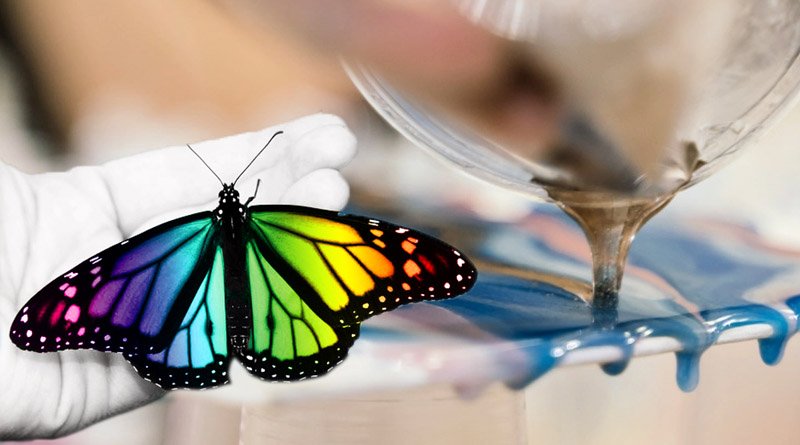A new paint that uses less energy, can be painted any colour, and should last for centuries has been created by researchers. The lightest paint ever made is also this one.

A new paint that uses less energy, can be painted any colour, and should last for centuries has been created by researchers. The lightest paint ever made is also this one. This paint is not made of pigment and was inspired by butterfly wings. The arrangement of nanoparticles instead produces colour structurally. The project is known as “plasmonic paint.”
According to their calculations, covering a Boeing 747 would only require 1.4 kilograms (3 pounds) of plasmonic paint as opposed to at least 454 kilograms (1,000 pounds) of conventional commercial paint. As a result, it might significantly cut down on the quantity of greenhouse gases needed for flight. We are a long way from mass producing this lightest paint because it has only been developed in the lab.
However, using methods that are easily scaled up, the researchers have already produced the paint in a variety of colours, and that is what they will be focusing on next. The ability of this paint to keep structures cooler is a major driver for its commercialization. Less heat is absorbed because of the structure of plasmonic paint, which reflects the entire infrared spectrum.
According to the researchers, surfaces painted with the new paint maintain a temperature that is 13 to 16 degrees Celsius (25 to 30 degrees Fahrenheit) lower than they would if painted with regular commercial paint.
The team that developed the paint was led by Nano scientist Debashis Chanda from the University of Central Florida. “Over 10% of total electricity in the US goes towards air conditioner usage,” he says.
“Plasmonic paint’s promise of a temperature difference would result in significant energy savings. Additionally, reducing the amount of electricity used for cooling would reduce carbon dioxide emissions, slowing global warming.”
Currently, pigment-based paints need specific molecules to create colour, and in most modern paints, those molecules are synthesised artificially. Each molecule’s electronic characteristics determine how much light is absorbed and, as a result, which colour the paint will appear. For every new paint colour, a new pigment is therefore required.
Plasmonic paint, on the other hand, makes use of nanoparticles made of the colourless metals aluminum and aluminum oxide. On top of an oxide-coated aluminum mirror, they can be arranged in a variety of ways to alter how light is reflected, scattered, or absorbed.
The vibrant colour of butterfly wings is produced by a similar process. According to Chanda, “The variety of colours and hues in the natural world is astonishing, from vivid flowers, birds, and butterflies to aquatic life like fish and cephalopods.” “In a number of exceptionally colourful species, structural colour acts as the main source of colour, producing all hues through the geometrical arrangement of typically two colourless materials. On the other hand, new molecules are required for each colour present in [human-made] pigment.”
The structural colour of the paint is what makes it so thin; it reaches full coloration at a thickness of just 150 nanometers, making it the lightest paint ever. In this study, the team used an electron beam evaporator, which precisely controls the rate of heating, to produce the structural paint.
Small clusters of aluminum nanoparticles can self-assemble thanks to controlled evaporation because the aluminum atoms are more attracted to one another than to the oxide substrate on which they were grown. The team can produce structures that reflect various colours by adjusting the pressure and temperature of the electron beam evaporator.
This pressure- and temperature-controlled process ensures high reproducibility over broad areas in a single step, lowering the cost of production and enabling large-scale fabrication.
The researchers also combined their structural color flakes with a commercial binder, which means the paint will last for hundreds of years. This isn’t the first new kind of paint to promise some incredible properties, such as Vantablack, which can absorb 99.96 percent of light.
Because of tiny carbon nanotubes, which are similar to plasmonic paint in their super-blackness, even blacker paints have since been produced using the same technique. Additionally, there is ultra-white paint, which reflects 98.1 percent of all light and is designed to drastically cut down on the need for air conditioning.
But unlike plasmonic paint, which uses pigments to reflect light, Vantablack only comes in one colour at the moment. However, there is still a long way to go before everyone can create their own plasmonic paint colours and paint an entire house with just one tiny can.
According to Chanda, “the traditional pigment paint is made in sizable facilities where they can make hundreds of gallons of paint.” “At the moment, it is still expensive to produce at an academic lab unless we go through the scale-up process.”